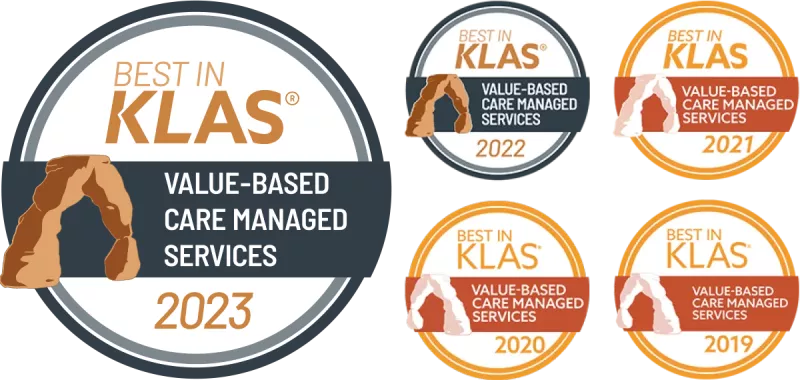
Value-based care software
Successfully providing value-based care requires a thorough understanding of quality metrics, HCC risk scores, cost and utilization of care in your population, patient engagement and outreach strategies, and more. With Arcadia, you can aggregate this data into a single platform, analyze trends and spot opportunities, act on insights across the care continuum, and automate tedious processes so your teams can get back to the work that matters most.

2023 Best in KLAS Award winner for value-based care managed services
Don’t go it alone. Tap into decades of experience with Arcadia’s Value-Based Care Software, recognized as Best in KLAS five times in a row for delivering reduced medical expenses, improved risk adjustment accuracy, and higher quality care to CINs, ACOs, and healthcare systems who decide to take on risk.
Put your data to work. Partner with a value-based care provider who gets it.
In-visit diagnosis capture
More closed risk per patient
Reduction inpatient admissions
Reduced post discharge
Higher MSSP bonuses
Days reduction post acute ALOS
Partner with the experts in value-based care
Get in touch to partner with Arcadia’s value-based care solutions today.
This site is protected by reCAPTCHA and the Google Privacy Policy and Terms of Service apply.
Value-based care isn’t an easy endeavor
From compliance to clinical buy-in, accepting risk takes a village. But advancing patient care and keeping costs low is an ongoing challenge. Since reimbursements are dependent on clinical outcomes, your organization can’t afford to miss its value-based benchmarks. Organizations that adopt value-based contracts need a software solution that can keep pace by seamlessly integrating workflows, patient outreach methods, and risk assessment.
Reimagine care delivery with comprehensive software
Achieve your value-based care goals with a solution that makes fragmented care a thing of the past. Employ risk stratification algorithms to allocate resources with precision and efficiency all while keeping costs down. With Arcadia’s value-based care software, your team can reap the benefits of a data-driven approach to healthcare delivery. Your job? Focus on delivering quality care to your patients.

Take on risk without fear
Partner with a value-based care software provider who gets it. With Arcadia, you can make sense of your data and put it to work for your at-risk contracts. Our software will help you identify top priorities for compliance, high-risk patients, and process improvements so you can get to value quicker.

Impact population health without the guesswork
Success in value-based care requires a healthy population. Identifying the highest-risk patients and resolving their care needs while keeping healthy patients out of the office is crucial. With Arcadia’s value-based care software, you can leverage instant insights to manage at-risk contracts with accuracy and efficiency.

Aggregate high-quality, comprehensive, and up-to-date data assets

Surface actionable insights to improve care and quality

Enable teams with workflows and insights at the point of care

An entire software suite dedicated to your value-based contracts
Don’t make the leap to value on your own. Coordinate care between providers, implement value-based payment models throughout your network, and keep costs low for your population. Partner with Arcadia Analytics for value-based care solutions that drive real results.

Embracing value-based care: from risky business to data backed decisions
Embracing value-based care solutions doesn’t mean taking on risk needs to be a daunting endeavor — learn how a solid data foundation can help.
The efficiency, support, and expertise that Arcadia provides to us through our audit and submission process are really invaluable to us. Having a great tool and partner saves us a ton of hours and heartache. Arcadia has really helped us succeed. They have helped us not only with the efficiency piece but also financially. Things happen in the audit process that we catch through Arcadia’s tool and their partnership that translate into real dollars. We feel pretty strongly about continuing our relationship with the managed services. I expect to continue to be extremely satisfied.
Partner with the experts in value-based care
Get in touch to partner with Arcadia’s value-based care solutions today.
This site is protected by reCAPTCHA and the Google Privacy Policy and Terms of Service apply.
